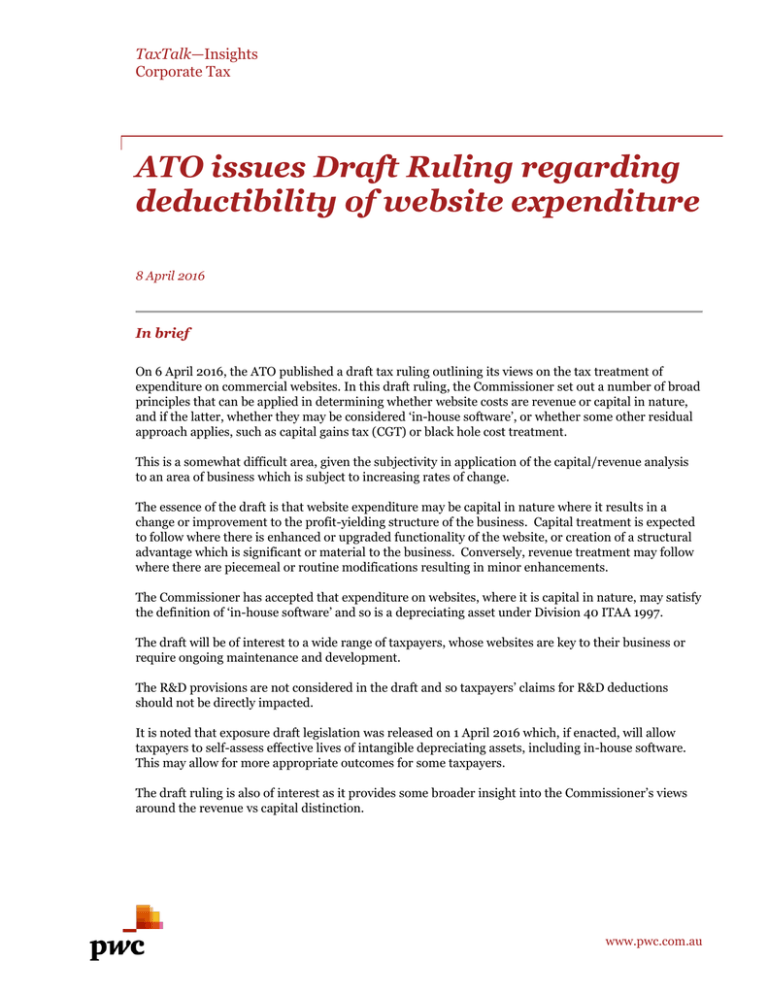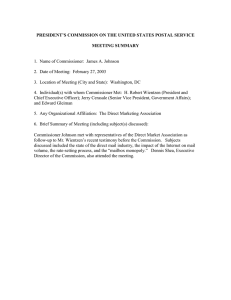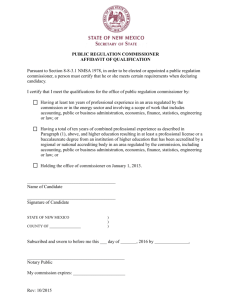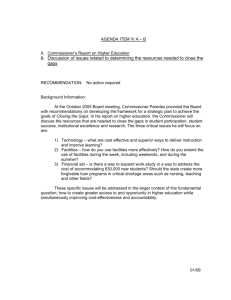
TaxTalk—Insights
Corporate Tax
ATO issues Draft Ruling regarding
deductibility of website expenditure
8 April 2016
In brief
On 6 April 2016, the ATO published a draft tax ruling outlining its views on the tax treatment of
expenditure on commercial websites. In this draft ruling, the Commissioner set out a number of broad
principles that can be applied in determining whether website costs are revenue or capital in nature,
and if the latter, whether they may be considered ‘in-house software’, or whether some other residual
approach applies, such as capital gains tax (CGT) or black hole cost treatment.
This is a somewhat difficult area, given the subjectivity in application of the capital/revenue analysis
to an area of business which is subject to increasing rates of change.
The essence of the draft is that website expenditure may be capital in nature where it results in a
change or improvement to the profit-yielding structure of the business. Capital treatment is expected
to follow where there is enhanced or upgraded functionality of the website, or creation of a structural
advantage which is significant or material to the business. Conversely, revenue treatment may follow
where there are piecemeal or routine modifications resulting in minor enhancements.
The Commissioner has accepted that expenditure on websites, where it is capital in nature, may satisfy
the definition of ‘in-house software’ and so is a depreciating asset under Division 40 ITAA 1997.
The draft will be of interest to a wide range of taxpayers, whose websites are key to their business or
require ongoing maintenance and development.
The R&D provisions are not considered in the draft and so taxpayers’ claims for R&D deductions
should not be directly impacted.
It is noted that exposure draft legislation was released on 1 April 2016 which, if enacted, will allow
taxpayers to self-assess effective lives of intangible depreciating assets, including in-house software.
This may allow for more appropriate outcomes for some taxpayers.
The draft ruling is also of interest as it provides some broader insight into the Commissioner’s views
around the revenue vs capital distinction.
www.pwc.com.au
In detail
In conjunction with several of its clients, PwC Australia initiated dialogue with the Australian Taxation
Office (ATO) around two years ago, during which we sought guidance regarding income tax treatment
of website expenditure, given the absence of ATO interpretive material since the 2009 repeal of TR
2001/6. Given the increasing significance of websites and online businesses (and the growing
quantum of spend for some businesses), it was important for taxpayers to obtain clarity around the
Commissioner’s views regarding treatment of such expenditure.
Following the dialogue, on 6 April 2016, the ATO issued draft Taxation Ruling TR 2016/D1 Income
Tax: deductibility of expenditure on a commercial website (the Draft Ruling). In the Draft Ruling,
the Commissioner has sought to apply existing concepts of capital and revenue to characterise the
different types of costs that may be involved in development and maintaining a website.
Capital vs revenue characterisation
The Commissioner considers that website expenditure may be capital where it results in a change or
improvement to the profit-yielding structure of the business. Capital treatment is expected to follow
where there is enhanced or upgraded functionality of the website, or creation of a structural advantage
which is significant or material to the business. Conversely, revenue treatment may follow where
there are piecemeal or routine modifications resulting in minor enhancements. The table below
provides a brief summary of types of spend that the Commissioner considers can be categorised as
either capital or revenue.
Capital
Revenue
Labour costs that are directly referable to the
enhancement of the profit yielding structure of
the business
Expenditure on ‘off-the-shelf’ software that is
licenced periodically
‘Off-the-shelf’ software products where the
product provides an enhancement of the profit
yielding structure of the business
Periodic operating, registration and licensing
fees
Expenditure incurred in acquiring or developing
a commercial website for a new or existing
business
Expenditure incurred in maintaining a website
Expenditure that adds new functionality or
materially expands existing functionality
Expenditure on modifications to a website that
add minor functionality or make minor
enhancements to existing functionality
Content migration as part of establishing a new
website
Expenditure incurred in maintaining a social
media presence and updating content
An amount paid once-and-for-all to secure the
right to use a domain name
Periodic registration fees for domain names
PwC
Page 2
The approach taken in the Draft Ruling is to provide some broad principles that can be applied when
determining whether website costs are capital or revenue in nature. The Draft Ruling emphasises that
characterisation is a matter of fact and degree. This approach, however, leaves taxpayers with the
challenge of applying somewhat subjective analysis to potential assets which, by their nature, are often
changeable and constantly evolving.
The Commissioner considers the key question in determining whether an amount is capital to be: to
what extent does the expenditure enhance or augment the profit-yielding structure of the business?
The Commissioner considers the degree of ‘enduring benefit’ to be secondary.
The Commissioner notes that factors to be taken into account in making this assessment include the
following:
The role of the website in the business
The nature of the modification to the website
The size and extent of the modification
The degree of planning and level of resources employed in effecting the modification
The level of approval required for the modification
The expected useful life of the modification.
As noted above, these factors are quite broad, and the challenge will be the judgment required in
applying them to the relevant facts.
Synthesizing the Commissioner’s comments and the discussion in its 21 examples, the ATO considers
the following are likely to give rise to capital treatment:
Extended or new functionality
Upgrades
Modifications resulting in structural advantage
Replacement of a material part of the commercial website is a structural advantage
Piecemeal modifications that are part of a program of work
Creation of a business asset or advantage that is distinct from the website
The Commissioner notes that in assessing the advantage obtained, consideration needs to be given to
the ‘significance’ or ‘materiality’ of the advantage or the size of spend, and this judgment needs to be
made from a practical and business perspective.
In-house software
The Commissioner has agreed that, to the extent expenditure is considered to be capital in nature,
website expenditure may fall within the definition of in-house software. ‘In-house software’ is defined
in s995-1 ITAA 1997 as follows:
"in-house software " is computer software, or a * right to use computer software, that you
acquire, develop or have another entity develop:
a) that is mainly for you to use in performing the functions for which the software was
developed; and
b) for which you cannot deduct amounts under a provision of this Act outside Divisions 40 and
328.
PwC
Page 3
“Software” is not defined in the tax law and so takes its ordinary meaning. The Commissioner’s view
is that, “software is, functionally, anything that instructs another part of the computer system; more
generally, it is a digital system made up of programs, data and associated documentation. It may
include data and website content.”
Accordingly, it appears from the Draft Ruling that the Commissioner agrees that websites typically fall
within the concept of software and in-house software. It is noted that in-house software does not
include application software made available to download for offline use. This could be a fine
distinction, as the Commissioner notes that software provided on a commercial website for
installation on the user’s device is nonetheless in-house software provided it has a purpose solely to
provide a user interface for interacting with the business.
The Commissioner confirms in one of the examples (in the section of the Draft Ruling that will be
binding) that a mobile banking app is in-house software, because it facilitates interaction between the
customer and the bank, notwithstanding that it is downloaded onto the user’s device.
The Commissioner notes in the Draft Ruling that other provisions may apply to the extent s8-1 or the
in-house software provisions are not applicable. CGT treatment and s40-880 are referred to, but not
covered in significant detail.
In total, the Commissioner has provided 21 examples in the Draft Ruling, to help illustrate the
application of the principles outlined in the Draft Ruling. Whilst these examples are useful in
understanding the Commissioner’s view, they also highlight some of the challenges involved in
categorising website expenditure. For example, the Draft Ruling includes several welcome examples of
website modifications that are considered to be “minor” and hence revenue in nature, including
upgrades to user-monitoring software to better understand the visitor profile and use of its website,
and the addition of a new payment option to an online sales facility. These can be contrasted with an
example of back-end upgrades to website architecture which, in those examples, are considered to be a
structural enhancement to the business. One of the distinguishing features between these examples
appears to be the expectation of the need for further enhancements to the website within the short
term (12-18 months) or the long term (more than 2 years). Given the pace of change in this area, it
may be difficult to distinguish between minor and major website upgrades in this way. The
Commissioner also has taken the view that regular updates resulting in gradual improvements are
capital in nature where they are part of a broader program which can be considered to be an ‘upgrade
as a whole’. We expect this to be difficult for some taxpayers, given the fact that websites require
ongoing improvement just to remain functional and relevant in the market, and the question of
whether discreet updates should be considered to be separate or part of an overall program presents
similar challenges to the ‘functional unit’ analysis in the context of websites.
Another example in the Draft Ruling highlights modifications to a website for mobile devices, and
draws a distinction between adapting the existing website to display content in a smart phone friendly
layout (an ordinary business expense that is deductible) and creating a separate website exclusively for
mobile device access to which mobile device browsers will be automatically redirected (capital in
nature). This highlights the subtlety of interpretation and the difference in outcomes that can arise
where facts are changed in an arguably fairly minor way.
The Draft Ruling, once finalised, is intended to apply both before and after its date of issue.
Comments on the Draft Ruling can be made until Friday 20 May 2016.
PwC
Page 4
The takeaway
The Draft Ruling, if finalised, will provide some welcome clarification regarding the Commissioner’s
views. It is positive that the Commissioner has agreed that expenditure which is not revenue in nature
may in many cases constitute in-house software, which in our view is the most reasonable
interpretation of the legislation and the underlying policy intent. It is also positive to have guidance
confirming that operating or maintenance-type activities can be revenue in nature.
The challenges, as noted above, are likely to arise from the breadth and subjectivity of the indicia put
forward in the Draft Ruling (for example, the use of undefined terms such as material, significant,
and minor, piecemeal) and these concepts will need to be considered in the context of the business
and the role the website plays within it. Our experience in practice is that websites are often
constantly evolving and may be updated regularly, sometimes daily or more, and a website may
dramatically change over the course of one to two years, but the changes may be made through
numerous incremental updates or releases, each of which (of itself) may be insignificant. Overlaying
the concepts of the Draft Ruling in such circumstances could be challenging. Taxpayers will need to
ensure they have appropriately assessed their facts and documented their positions.
Again, it is relevant to note that on 1 April 2016, the Australian Treasury released Exposure Draft
legislation which, if enacted, will allow taxpayers the option to self-assess effective lives of intangible
assets, so that in-house software may be assessed to have a life other than 5 years, for assets an entity
starts to hold from on or after 1 July 2016. This means that more appropriate outcomes can be
achieved for taxpayers where their website expenditure is capital and they are able to align their
effective lives with the reality of their websites.
Let’s talk
For a deeper discussion of how these issues might affect your business, please contact:
Anthony Klein, Melbourne
+61 (3) 8603 6829
anthony.klein@au.pwc.com
Warren Dick, Sydney
+61 (2) 8266 2935
warren.dick@au.pwc.com
Paul McNab, Sydney
+61 (2) 8266 5640
paul.mcnab@au.pwc.com
Magnus Morton, Melbourne
+61 (3) 8603 3922
magnus.morton@au.pwc.com
© 2016 PricewaterhouseCoopers. All rights reserved. In this document, “PwC” refers to PricewaterhouseCoopers a partnership
formed in Australia, which is a member firm of PricewaterhouseCoopers International Limited, each member firm of which is a
separate legal entity. This publication is a general summary. It is not legal or tax advice. Readers should not act on the basis of this
publication before obtaining professional advice. PricewaterhouseCoopers is not licensed to provide financial product advice under
the Corporations Act 2001 (Cth). Taxation is only one of the matters that you need to consider when making a decision on a
financial product. You should consider taking advice from the holder of an Australian Financial Services License before making a
decision on a financial product.
PwC
Liability limited by a scheme approved under Professional Standards Legislation.
Page 5



